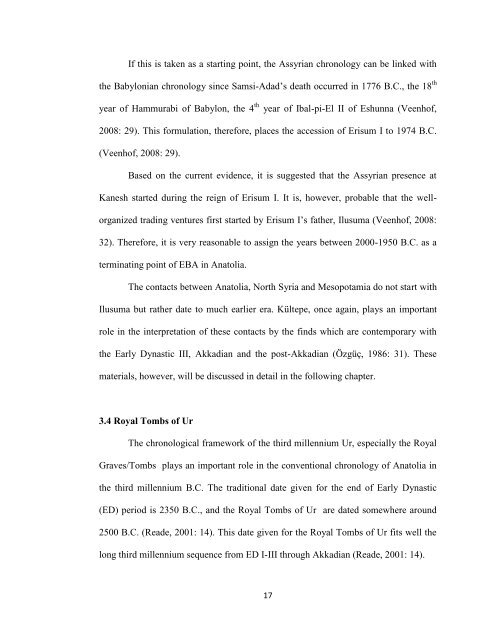EARLY BRONZE AGE DAGGERS IN CENTRAL ... - Bilkent University
EARLY BRONZE AGE DAGGERS IN CENTRAL ... - Bilkent University
EARLY BRONZE AGE DAGGERS IN CENTRAL ... - Bilkent University
You also want an ePaper? Increase the reach of your titles
YUMPU automatically turns print PDFs into web optimized ePapers that Google loves.
If this is taken as a starting point, the Assyrian chronology can be linked with<br />
the Babylonian chronology since Samsi-Adad’s death occurred in 1776 B.C., the 18 th<br />
year of Hammurabi of Babylon, the 4 th year of Ibal-pi-El II of Eshunna (Veenhof,<br />
2008: 29). This formulation, therefore, places the accession of Erisum I to 1974 B.C.<br />
(Veenhof, 2008: 29).<br />
Based on the current evidence, it is suggested that the Assyrian presence at<br />
Kanesh started during the reign of Erisum I. It is, however, probable that the well-<br />
organized trading ventures first started by Erisum I’s father, Ilusuma (Veenhof, 2008:<br />
32). Therefore, it is very reasonable to assign the years between 2000-1950 B.C. as a<br />
terminating point of EBA in Anatolia.<br />
The contacts between Anatolia, North Syria and Mesopotamia do not start with<br />
Ilusuma but rather date to much earlier era. Kültepe, once again, plays an important<br />
role in the interpretation of these contacts by the finds which are contemporary with<br />
the Early Dynastic III, Akkadian and the post-Akkadian (Özgüç, 1986: 31). These<br />
materials, however, will be discussed in detail in the following chapter.<br />
3.4 Royal Tombs of Ur<br />
The chronological framework of the third millennium Ur, especially the Royal<br />
Graves/Tombs plays an important role in the conventional chronology of Anatolia in<br />
the third millennium B.C. The traditional date given for the end of Early Dynastic<br />
(ED) period is 2350 B.C., and the Royal Tombs of Ur are dated somewhere around<br />
2500 B.C. (Reade, 2001: 14). This date given for the Royal Tombs of Ur fits well the<br />
long third millennium sequence from ED I-III through Akkadian (Reade, 2001: 14).<br />
17
















